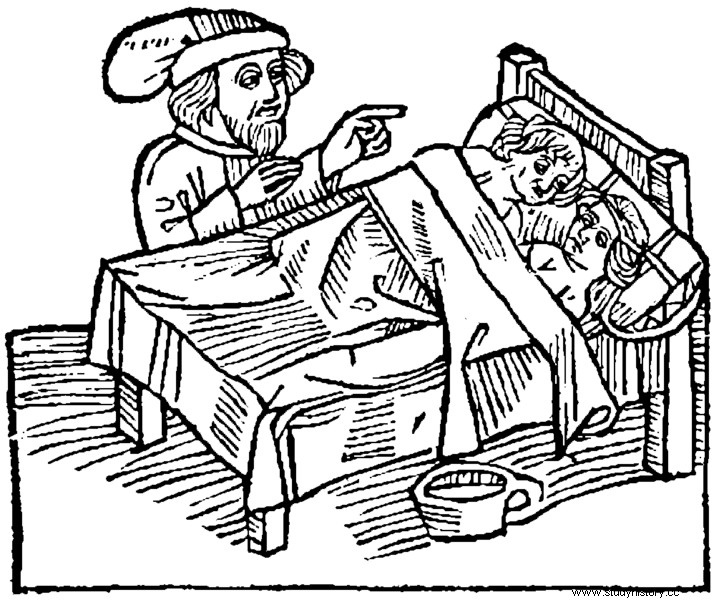With the decline of the medieval world, which occurred throughout the fifteenth century, a return to the values of classical Greco-Roman culture was sought in Europe, the Renaissance began . Although there was also a renewal in the world of science, the main stronghold and exponent of the Renaissance can be found in the field of the arts. Leaving behind the feudal system, a new social class would begin to emerge, the bourgeoisie, which would lay the foundations of capitalism and a mercantile economy, and would be the standard-bearer of a cultural and intellectual movement in the mid-eighteenth century, the Enlightenment . This movement would culminate in the French Revolution (Liberté, égalité, fraternité ) and the Industrial Revolution. From this new society, completely different from the one imposed by kings, nobles and clergy during the Middle Ages, it is easy to "sell" the Middle Ages as a dark age of ignorance and barbarism. And, logically, create myths attributed to this time, such as the chastity belt and the right of pernada.
Chastity belt.
In the most widespread version of chastity belts, the gentlemen put these devices on their ladies to protect their "most precious treasure" and, thus, leave calmly and concentrate on the battle. These gadgets, usually metallic and more typical of torture instruments, would be placed between the woman's thighs and had two holes that allowed urine, feces and menstrual blood to be evacuated, but prevented the entry of daring visitors.

Other versions, not so fictional, take shape and deny their existence based on the difficulties of movement or even sitting and, above all, on the lacerations or ulcers with infections that long-term use could cause (wars could last months). or even years) of these feminine accessories. Moreover, it is even believed that they could be used by women themselves, in more bearable versions and for short periods of time, to protect themselves from frequent rapes during soldiers' quarters or on sea voyages.
Right of pernada.
The expression right of pernada (in Latin Ius primae noctis , «right of the first night») refers to an alleged privilege or feudal right by which the nobles had the power to spend the wedding night with the wife of their vassals, and that the husband could avoid by payment if the lord consented .

It is true that in the Middle Ages there was the formariage or matrimonial servitude, an amount that was paid to the lord by the servant who married and whose amount depended on whether or not the other party belonged to the same fiefdom. And it is also true that the feudal lords had the power to decide on numerous matters in the lives of their serfs and their possessions, and therefore abuses of all kinds were the order of the day in this relationship of vassalage or servitude close to slavery. Therefore, the feudal lord did not need to invoke rights to commit abuses, including sexual ones, and get away with it.
Some believe they see a confirmation of this right in the Guadalupe Arbitration Decision (1486), enacted by the King of Aragon Ferdinand II and which put an end to the Remensas War in Catalonia, when he says…
[...] nor can [the lords] the first night that the peasant seizes a woman to sleep with her or as a sign of lordship on the night of the wedding that the woman will be thrown in bed to pass over her on the said woman.
Let us remember that the Remensa War in Catalonia broke out in response to the servitude rights and the abusive practices to which the Catalan peasants (payeses) were subjected by the feudal lords, especially due to the so-called remensa – se considered that the peasants were linked to the land they worked and, therefore, could be sold or inherited with it, and the only way to free themselves was by assuming the payment of a ransom called remensa. The Crown, for that of "liberating the oppressed" and, above all, for limiting the power of the nobility, made the demands of the peasants their own. Although this sentence, and this text in particular, could confirm the existence of the pernada right, the reality is that said document refers to limiting the rights of the lords over the serfs and abolishing the abusive practices that some lords, in the relationship of power with their servants, they were able to convert into custom. In fact, in the same sentence it is also prohibited that the lords take the wives of the peasants as wet nurses for their children; a clear example of an abusive practice and not of a right. Therefore, these prohibitions refer to the abusive practices of some gentlemen that the peasants denounced to the Crown. So, we are not talking about a manorial right, but about SEXUAL ABUSES.
Both the myth of the use of chastity belts and the urban legend of the pernada right served the Enlightenment as proof of the ignominy and barbarism of feudalism, an era that was only overcome when the ideals championed by the Enlightenment itself triumphed:reason, critical spirit, scientific progress, liberalism... The more barbaric and dark medieval society was painted, the better a society based on the ideals of the French Revolution and the Enlightenment would "sell".
